Primary Drivers of Deforestation Un Soy, Beef, Wood Prducts
Woods Cover 55 – The big four drivers of deforestation: beef, soy, woods and palm oil
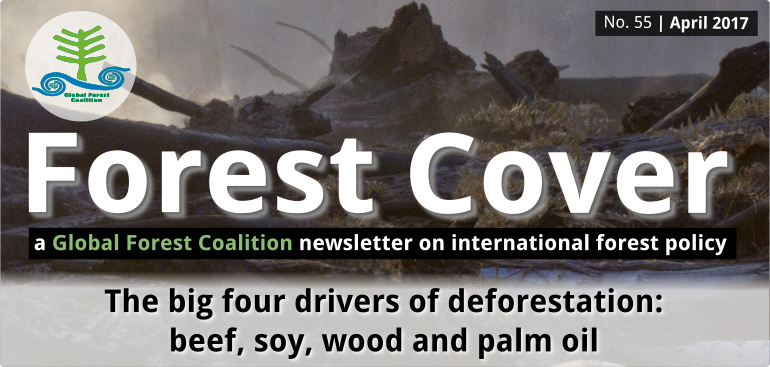

Welcome to Forest Encompass No. 55. Forest Encompass is Global Forest Coalition'southward newsletter. Information technology provides a space for environmental justice activists from across the globe to present their views on international wood-related policies.
Forest Cover 55 looks at merchandise in just four fundamental commodities—beef, soy, woods, and palm oil—which together are the main drivers of deforestation in the world. Demand for these bolt is leading to huge swathes of forest being replaced by vast monoculture plantations and pasture, specially in the global South. Beef is the worst deforesting culprit and clearing forests to make style for pasture was responsible for 71% of deforestation in vii Latin American countries. Palm oil is second just to beef and is leading to serious deforestation in Southeast Asia—300 football game fields of forest are lost in Indonesia for palm oil every hour! This upshot brings us stories from around the earth where forests and communities face the impacts of the production and merchandise in these bolt. It too showcases campaigns as communities beyond the earth struggle to stop these drivers of forest loss.
You can download the print version or read the articles individually beneath. To subscribe to the newsletter, please write to gfc@globalforestcoalition.org.
Download the print version (web quality) or (low resolution PDF)
Contents:
Editorial: Driving deforestation
Burning copse while saving forests? The mythology of bioenergy
Palm oil and state grabbing in Cameroon
Biofuels for aviation: about to take off?
Natural pino forests rich in biodiversity threatened by logging in Sweden
Booming trade in biofuels and biomass devastating the Czech Commonwealth's wetlands, farms and forests
Less meat, more than forest: Brighter Green's work in China
What is being sacrificed for your premium slice of steak?
Editorial: Driving deforestation
Past Ashlesha Khadse, Global Woods Coalition, Republic of india

Alysson D. Flynn/Flickr
Trade, international and national, in just four key commodities—beefiness, soy, woods, and palm oil—is the main cause of deforestation in the world. Increasing need for these woods-destroying commodities is leading to huge swathes of forest being replaced past vast monoculture plantations and pasture, especially in the global South.
Beef is the worst deforesting culprit, and South America, habitation to the earth'south most precious tropical forests, is a region dramatically impacted by need for livestock products. For case, information technology was constitute that betwixt 1990 and 2005 clearing forests to make manner for pasture was responsible for 71% of deforestation in 7 Latin American countries. [1] Palm oil is second but to beef in its climate impacts and is leading to serious deforestation in Southeast Asia—300 football fields of woods are lost in Indonesia for palm oil every hour! [2]
In fact, these impacts are experienced everywhere, including in Europe and Due north America. This 55th edition of Forest Cover brings us stories from across the earth where forests and communities confront the impacts of the production and trade in these commodities. It also showcases peoples' campaigns equally people across the globe struggle to end these drivers of woods loss.
Biofuelwatch is at the forefront of campaigns to challenge the use of wood for fuel on an industrial scale. Rachel Smolker'southward article reveals the way in which forests in the southeast of the USA are beingness felled to create wood pellets for export to Europe for supposedly 'sustainable' biofuels, exposing not just the scale of this destructive trade, just the mode in which it is actively contributing to deforestation and climatic change.
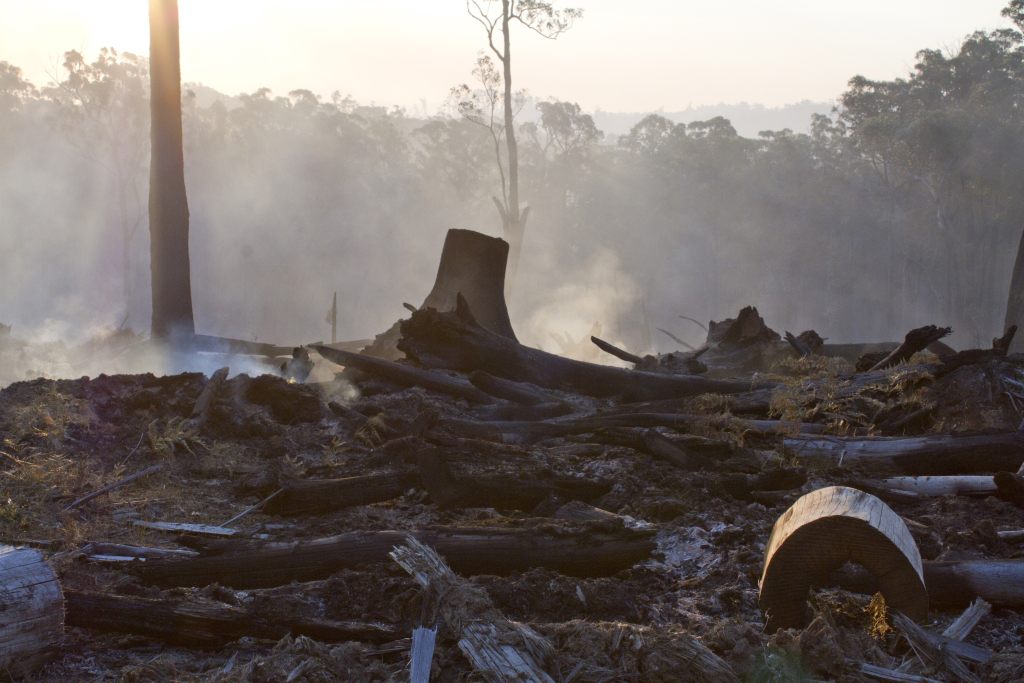
Forest devastation in Australia. Judith Deland/CIC
The Center for Environment'southward (CED) article speaks near the tangible impacts of palm oil production upon communities and countries. It shows usa how transnational corporations have been grabbing massive tracts of land to produce palm oil in Cameroon. Gross human rights violations, and ecology devastation lie behind palm oil. Despite this, the interest in palm oil as a source of 'sustainable' energy is on the rise. In fact, the highly polluting aviation manufacture is besides looking to shift to palm oil based biofuels every bit described in Almuth Ernsting's article. The International Civil Aviation System, ICAO, (a specialised UN organisation that regulates the airlines industry), has been pushing for the employ of biofuels as a 'renewable' source of fuels, a completely erroneous idea.
Kristina Bäck shows us how these problems are not unique to the Global S by bringing us a story from Sweden. The Swedish Woods Agency has been granting controversial permissions to log sometime growth virgin forests similar the Ore Forest Landscape. Sweden has been trying to phase out fossil fuels, replacing them with what it considers to be renewable energy including woods-based biomass sourced from old growth forests both from within its ain boundaries and past importing wood pellets. [3,4] Many of these forestry companies like the state owned Sveaskog described in the article are certified by agencies like the Forest Stewardship Council, showing the states but how petty and misleading such certifications tin be. Zdeněk Poštulka also shows us how trade in biomass for bioenergy inside the Eu is devastating Czech Democracy's wetlands, farms and forests.
The production of meat and dairy is another major driver of wood loss, as highlighted in earlier issues of Forest Cover. [5] But there are stories of hope too. Wanqing Zhou takes us to Red china to talk about her organization Brighter Green'southward ground-breaking work on meat consumption in China, exploring the links with increasing deforestation from meat production in Latin America.
Finally, Mary Louse Malig puts a compelling spotlight on global trade negotiations and trade agreements as drivers of this forest loss. The EU-Mercosur negotiations that Malig describes are a key loonshit for Mercosur countries to increase their beefiness exports to the EU, potentially at the expense of Latin American forests. The negotiations, if finalised, will benefit agribusiness and lead to the further expansion of beef and feedstock production, especially soy for animal feed, to the detriment of forests and the women and men who depend on forests for their daily livelihoods.
[one] De Sy et al (2015). Country use and related carbon losses following deforestation in South America, De Sy V, Herold M, Achard F, Beuchle R, Clevers JGPW, Lindquist E & Verchot LV, 2015 http://world wide web.cifor.org/library/5892/landuse-patterns-and-related-carbon-lossesfollowing-deforestation-in-due south-america/
[2] https://deforestationandpalmoil.weebly.com/uploads/1/8/8/5/18854416/wwf.pdf
[three] http://www.fern.org/sites/fern.org/files/Biomass%20imports%20to%20the%20EU%20final_0.pdf
[iv] http://bio-fuel-watch.blogspot.in/2011/02/controversial-logging-exposes-swedens.html
[v] https://globalforestcoalition.org/resources/forest-cover-bug/forest-encompass-49-meat-driver-deforestation/
Burning trees while saving forests? The mythology of bioenergy
By Rachel Smolker, Biofuelwatch, U.s.a. and GFC Board member

Dogwood Alliance
Agriculture, livestock production and logging remain leading drivers of deforestation. But so-called 'modern' commercial and industrial-calibration bioenergy is becoming increasingly prominent. Though rarely recognised, currently more than half of the energy classed as 'renewable' in the EU [ane], and only slightly less in the Usa, consists of bioenergy—biofuels for transportation and burning wood/trees for electricity. Renewable energy promotional materials tend to feature images of solar panels and wind turbines, avoiding the rather less bonny reality of smokestacks, industrial corn and soya farms, and palm oil plantations.
Awareness of the problems with large-scale bioenergy has grown, forth with a massive torso of scientific literature detailing advertizement infinitum that because of the large land footprint required and the length of time which forests need to grow, large calibration bioenergy (in pretty much whatsoever form), results in more, rather than less, climate-dissentious emissions, while too destroying biodiversity, displacing nutrient production, and undermining human rights.
Biofuelwatch first turned its attending to wood bioenergy when it became clear to us that burning wood for electricity was likely to accept off dramatically. It is technologically straightforward (different, for example, cellulosic liquid biofuels) and tin enable coal plants and other pre-existing power plant infrastructure to remain viable, so it is favoured past the fossil fuel industry.
Furthermore, wood bioenergy can provide 'baseload' power (24/vii, yr circular), thus putting off the need to invest in the electricity storage and interconnectors which are needed to make 100% 'no-burn down' renewables viable. In improver, public sentiment towards burning wood equally renewable energy has been favourable. Information technology is viewed by the public and even environmentalists as 'natural'. Many environmental organisations initially promoted biomass enthusiastically, even those that subsequently shifted their position on ethanol as competition with food production was recognised. With mandated targets and subsidies in place, it seemed clear that wood biomass would be the 'low hanging fruit' for renewables and would speedily expand on a large scale. And it has.
Accounting trickery perpetuates the merits that wood bioenergy is 'carbon neutral' (because copse that are burned might somewhen regrow), allowing free energy producers to claim to be reducing emissions. Equally a result they likewise receive generous subsidies for burning forest, on the same footing equally—and therefore competing with—wind, solar and geothermal (not-combustion) renewables.
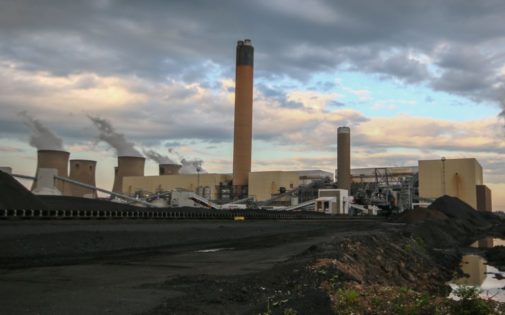
The existent face of renewable energy? Biomass is increasingly burned in coal-fired ability stations. nican45/Flickr
According to the International Free energy Agency (IEA), wood pellet product has skyrocketed, from half-dozen-7 million tonnes in 2006, to 26 million tonnes in 2015, increasing on boilerplate 14% twelvemonth on yr, and it is anticipated to continue to grow exponentially. [2] The bulk of international pellet merchandise occurs within European countries and between the US and EU, with companies such as DRAX, Oersted (formerly DONG), Eastward.On and RWE purchasing massive quantities of pellets, primarily from the southeastern USA. An estimated 35 pellet plants are now operating or proposed across the southern USA, each with a voracious non-stop ambition for forest. [iii]
While the biomass industry continues to claim they employ only 'waste and residue', it is clear as solar day that this is not the instance–the wood yards of these facilities are stacked with whole copse, including annihilation that is considered 'low form' that cannot be sold as timber.
An exposé of wood sourcing practices for the pellet manufacturer, Enviva, the largest producer in the Us, revealed they were in fact harvesting whole trees from rare remaining pockets of bottomland hardwood forests. [4] According to the Southern Ecology Law Center, over 168,000 acres of wetland wood were at high run a risk from simply this one facility. [5] Enviva ships much of the pellets they produce to the DRAX coal constitute in Britain, which has been converted to burn down 50% wood pellets. In 2016, DRAX burned half-dozen.6 one thousand thousand tonnes of pellets, [6] made from 13.2 million tonnes of wood (since two tonnes of wood are harvested for every tonne of pellets manufactured).
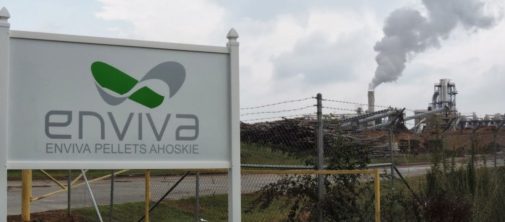
Enviva's Ahoskie wood pellet found. Dogwood Alliance
DRAX woods consumption is 1.6 times the Britain's full annual wood production! [7] Notwithstanding all of the trees that are cut down, pelletised and shipped across the ocean to burn, provide a mere 0.74% of the United kingdom's total energy need. [eight] Per unit of free energy generated CO2 emissions from called-for forest are higher even than for burning coal. [nine] Add to that emissions from aircraft the pellets across the sea, emissions from harvesting operations, transportation, drying, and pelletising, soil carbon losses from logging, and the foregone carbon sequestration associated with cutting the trees down, and whatever proclaimed climate benefit becomes mighty hard to discern. Every bit a reward for this absurdity, the United kingdom government grants DRAX an astonishing €one.5m in subsidies every unmarried day. [10]
When almost people hear this for the first fourth dimension, they are shocked and appalled. "You mean we are cutting down forests, turning them into pellets, shipping them beyond the ocean to burn in a coal establish, calling it renewable energy and paying subsidies for this equally a supposed climate solution?" people ask in amazement. It makes no sense, fifty-fifty to a child.
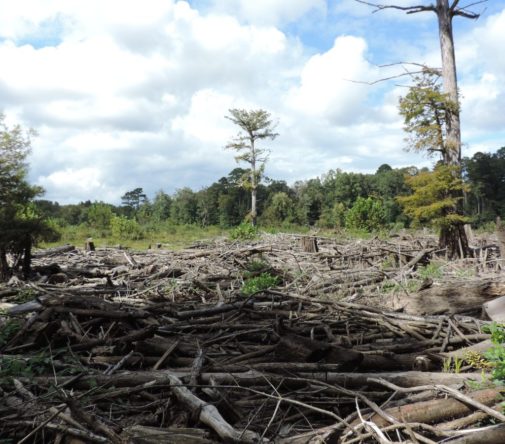
Wetland hardwood forest destruction for wood pellets, southern United states. Dogwood Alliance
Many organisations have taken on the result of the U.s.a./European union woods bioenergy debacle (including Dogwood Alliance, NRDC, Partnership for Policy Integrity, Fern and BirdLife International among others). However, despite these campaigns, politicians and policy meetings and even lobby campaigns seem incessantly mired in debates over carbon impacts and sustainability standards. We toil over grooming of study later report detailing the fallacy of burning copse for electricity. Over 800 scientists take written to Members of the European Parliament expressing their concern, stating: "Even if forests are allowed to regrow, using forest deliberately harvested for burning will increase carbon in the atmosphere and warming for decades to centuries—as many studies accept shown—even when wood replaces coal, oil or natural gas.'' [11]
It seems so nonsensical, and notwithstanding the policies supporting wood bioenergy (and bioenergy in general) remain, on the whole unchanged.
What will the futurity agree? Equally more and more nations get serious about addressing climate change, there is a risk that bioenergy may become increasingly entrenched as a 'solution'. New bioenergy-related developments and commitments loom on the horizon. Asian markets for wood pellets have been expanding, with growing need particularly from Nippon and Republic of korea. China has set up targets to replace a big portion of coal with woods pellets.
Indicative of this broad trend, a articulation "Biofuture Platform" initiative was launched past 19 nations at the Nov 2017 coming together of the UNFCCC in Bonn. Its stated objective is: "to increase the use of low carbon sources (i.e. sustainable bio-mass) equally the feedstock for the production of energy, chemicals and materials. In the non-and then-distant past, the world relied near entirely on renewable resource, including biomass, for nutrient, energy, and shelter. Nosotros ask y'all to envision a futurity where this is over again truthful – many modern needs including plastics, materials of construction, clothing and more than importantly energy, tin be met by biomass. Information technology has been estimated that, by 2050, one-half of [the] world's chemicals and materials could be produced from renewable resources." [12]
Of course, much of the world withal relies entirely on biomass for nutrient, energy and shelter. But the communities that still depend on 'traditional' biomass are amongst the world's everyman users of energy. If wealthy nations attempt to substitute biomass as a source for their massive free energy and material demands, at current levels of fossil-fuelled consumption, their demands will inevitably cease in contest with both food production and traditional uses–including by peasant farmers and Indigenous Peoples.
Even at electric current levels, it is articulate that bioenergy is a commuter of wood destruction. But, if the many diverse plans to expand its use come to pass, including plans for aviation biofuels and a vast 'bioeconomy', we may find ourselves denuding much of the planet in a misguided rush to'save it'.
As the bioenergy enthusiasts eyeball the planetary landscape to assess 'global biomass potential', there is simultaneously growing recognition of the important part that forests could play in staving off the worst impacts of global warming. There is much discussion about the potential for restoration and reestablishment of forests as an 'easily available' tool for sequestering carbon, while also providing many other benefits.
Merely how can we possibly reconcile massive demand for forest and bioenergy crops, with protection and restoration of forests? This is the puzzler that policymakers confront—the proverbial problem of 'how to have your cake and consume it too'. This discord seems to be a major wellspring of caput-spinning confusion and manipulative rhetoric about forests in the context of climatic change.
First of all, and very fundamentally, there still remains the ongoing charade inherent in the failure to formally distinguish between forests and tree plantations, by FAO, for example. This is in spite of many years of civil society pressure demanding a clear distinction. Just confounding the two provides a user-friendly loophole for the forestry manufacture. If the definition of 'forest' includes an industrial tree plantation destined to be harvested for pulp or bioenergy, and so the plantation possessor tin merits to exist growing a 'forest' while also claiming to provide renewable energy. One mode to have one'due south block and eat it besides.
In the The states, confusion, deceptive terminology and profound ignorance well-nigh wood ecology are the tools of the merchandise for forest and biomass industries eager to unravel woods protections. For example, the Trump administration recently introduced a "Resilient Forests Deed". Behind the prissy sounding name, the purpose of the bill is to open upwardly public lands to logging on a massive scale, while also curtailing requirements for environmental assessments and largely eliminating whatever public participation in decision-making.
The timber and biomass industries also have a long-continuing public relations campaign based on the merits that it is necessary to 'manage' (that is, log) forests to prevent wildfires that threaten people's lives and property. Their argument rests on the myth that if forests are not logged, they will accumulate likewise much biomass, and thus provide more fuel resulting in more severe fires. In fact, just the contrary is the case, every bit both mutual sense and science have shown. For example, a 2016 study demonstrated that the less a forest has been managed (logged), the less astringent the fires. [13] This makes sense to nigh people who take spent time in old growth and logged over forests. Logging disrupts the canopy, allowing more sunlight to penetrate, drying things out, and supporting the proliferation of flammable undergrowth. Further, it is well established that protecting lives and holding is all-time achieved past clearing trees in direct close proximity to homes, not miles away.
In 2017, when catastrophic wildfires swept through communities in California, republican leaders in the US Congress capitalised on the mood to promote their agenda, essentially arguing that forests should be cut down to forestall them from burning. [14] The biomass industry hopes for subsidies for 'thinning', based on fear of fire every bit a manner to acquire inexpensive feedstock for their projects.
Why has the industry been and so successful in perpetuating these myths? In the U.s.a., and perhaps elsewhere in the Global N, the answer may lie with an apathetic public that suffers from a profound lack of understanding almost forests. Urbanisation, and the failure of our education system, have resulted in a large portion of the population never having stepped foot in a real forest. If they take been into the forest at all, chances are it was really or had once been a tree plantation. Remaining patches of erstwhile growth forest, or even diverse and healthy secondary growth, are rare.
Following the industrial revolution and the "timber boom' that ensued in the early 1900s it is estimated that more than two thirds of American forests have been heavily cut or leveled at least once. The giants that were cutting – massive towering pines, huge, abundant and productive American chestnuts (a major staple nutrient source for wildlife and people alike), neat towering firs, hemlocks, cedars, oak and hickory have gone, some at to the lowest degree 200-400 years old when they were felled.
Regrowth, where information technology tin can occur, is a long, boring process, and most of united states volition never see a genuine former growth forest (though many second growth forests are now again spectacularly diverse and awe inspiring). We do not know what we are missing. Our sense of 'wood' lacks historical grounding and our knowledge of how forests piece of work—to back up life on earth—is woefully lacking. Hence we are broad open, vulnerable and undiscerning receptacles of nonsensical industrial propaganda.
Somehow, nosotros must observe our way back through the smoke and mirrors, across the propaganda and misleading terminology, to a reawakening of interest and awareness of the precious nature of existent forests. A wholesale rejection of the notion that forests are a source of 'renewable energy' is urgently needed as nations decide how to reduce greenhouse gas emissions.
[1] http://ec.europa.eu/eurostat/statistics-explained/index.php/File:Table_1-Share_of_renewables_in_gross_inland_energy_consumption_2016.png
[two] http://task40.ieabioenergy.com/wp-content/uploads/2013/09/IEA-Wood-Pellet-Study_final-2017-06.pdf
[3] https://www.southernenvironment.org/uploads/maps/SELC_WoodPelletExportMap_2017_0707_map+tabular array.pdf
[iv] https://www.nrdc.org/sites/default/files/enviva-wood-pellets-FS.pdf
[5] https://www.southernenvironment.org/news-and-press/press-releases/statement-from-selc-on-new-report-assessing-threats-to-southeast-wildlife
[vi] https://www.drax.com/wp-content/uploads/2017/03/Drax-Grouping-plc-annual-study-and-accounts-2016-Smart-Free energy-Solutions.pdf p18
[7] Drax burned half-dozen.6 1000000 tonnes of pellets in 2016 (https://www.drax.com/wp-content/uploads/2017/03/Drax-Group-plc-annual-report-and-accounts-2016-Smart-Energy-Solutions.pdf), fabricated from xiii.two million tonnes of green forest. By comparing, the Great britain's total wood production that year was 11 1000000 tonnes of green wood, according to the Forestry Committee (https://www.forestry.gov.uk/forestry/infd-7aqdgc).
[8] Burning 6.vi million tonnes of pellets generated 12.seven TWh of electricity in 2016 (https://world wide web.drax.com/wp-content/uploads/2017/03/Drax-Group-plc-almanac-report-and-accounts-2016-Smart-Energy-Solutions.pdf). The UK's total electricity utilize in 2016 was 303.8 TWh (https://www.gov.uk/government/uploads/arrangement/uploads/attachment_data/file/633029/DUKES_2017_Press_Notice.pdf), so Drax's biomass supplied iv.2% of Great britain electricity that twelvemonth. Yet, electricity contributed just 17.5% of the UK's final energy need that twelvemonth. And so Drax's biomass contributed 0.74% of the UK'due south final energy need in 2016.
[ix] http://world wide web.pfpi.net/carbon-emissions
[x] https://world wide web.drax.com/wp-content/uploads/2017/03/Drax-Group-plc-annual-study-and-accounts-2016-Smart-Energy-Solutions.pdf p128
[11] https://eutoday.net/news/energy/2018/scientists-urge-eu-to-revise-renewable-energy-directive
[12] http://biofutureplatform.org/statements/
[xiii] Bradley CM, Hanson CT and DellaSala DA (2016). Does increased woods protection correspond to higher fire severity in frequent-fire forests of the western United States? Ecosphere 7(10): e01492. ten.1002/ecs2.1492
[14] https://www.williamsnews.com/news/2017/november/07/house-approves-neb-speed-logging-combat-wildfires
Palm oil and land grabbing in Cameroon
By Center for Environment and Evolution (CED), Republic of cameroon

Center for Environs and Development
The financial crunch of 2008 and the subsequent growth in the need for land in sub-Saharan Africa by transnational corporations led to a blitz for state in Cameroon. Companies similar Sime Darby, the Siva Group/Biopalm Energy, Goodhope, Palmco, and SGSOC/Herakles all started requesting large areas of state for palm oil production.
Many of these companies were from Asia, which is a global leader in palm oil production. In Cameroon, a full corporeality of 3 to 4 million hectares was reportedly beingness claimed past these companies. [ane] In comparison, the size of existing agro-industrial plantations for all commodities in Cameroon was just 350,000 hectares at the time. Many of these claims remain unconfirmed, but SGSOC/Herakles, a New York based company, entered into a contract with the Government of Cameroon for 73,000 hectares of state. It was the commencement in a new moving ridge of country acquisitions, and CED was particularly active on this case because of the lessons that could be fatigued from it to inform advocacy work on the requested changes in the land law, especially regarding the provisions on large scale country concessions._
SGSOC/Herakles was the largest signed land deal in Cameroon at the time, and at least four lessons were learned from this case:
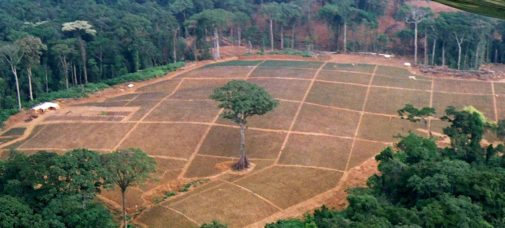
A newly-planted palm oil plantation in Republic of cameroon. Eye for Environs and Development
1. The issue of legality. The company claimed to have a contract for 73,000 ha merely was never able to provide prove of the size and location of the land that had been granted to them past the Government of Cameroon. They had a very detailed framework agreement with Cameroon, specifying the purpose (palm oil plantation), the hire (0.five-1 dollar per hectare per twelvemonth), the length of the concession (99 years), the cession of carbon rights to the company [two] (even though Cameroon did non have in place legislation to this effect), and a multifariousness of other details, simply neither the location nor the size were specified._
2. The complexity of the contract, which included so many detailed obligations for the host State, giving the impression that the contract was an asset in itself, and that the purpose was to pave the way for a future arbitration case.
3. The lack of advisable consultation with communities, and intimidation of community members either by the visitor or past the local administrative government and security forces. In some cases, the judiciary seemed to be privy to the harassment of community members or local activists during state transfers. [3] This trend gave the sad impression of a return to colonialism where land could be taken by strength from those needing information technology the nigh, without any due consideration for their livelihood or their future.
four. The quality of environmental and social standard requirements was poor. One of the land concessions claimed by the visitor was located in the middle of an ecologically sensitive area of 4 national parks or proposed national parks.
The deal was manifestly non a good one for the Cameroonian State, and NGOs were openly questioning why time to come land cessions should follow the path of the SGSOC concession. The conclusion of our findings was that the laws in Cameroon were not potent enough to regulate this new rush for lands. The legislation should include clearer provisions to protect the rights of communities and give them the priority over country and natural resources management. Environmental standards should be drastically improved as well, together with standards that protect the national development interests of the State._
The successful campaign to vocalism the concerns of communities and provide additional arguments based on research conducted by CED and its partners, brought together a number of NGOs in Cameroon and abroad, and led to a reduction in the size of the claimed concession (from 73,000 ha to xx,000 ha). [four] It likewise succeeded in replacing the claim with a provisional country charter, to exist renewed subject to the performance of the company._
CED has since been active in the ongoing discussion on the palm oil policy in Cameroon.
[1] http://pubs.iied.org/17571IIED/
[ii] http://www.relufa.org/savesite/documents/13REASONSCED-RELUFAdocENGLISHTRANSLATION.pdf
[3] https://world wide web.business-humanrights.org/en/complaint-earlier-u.s.a.-govt-alleging-intimidation-by-sgsocherakles-farms-in-land-transfers-in-cameroon-resolved-in-accord-between-company-ngos
[4] http://www.bad-ag.info/bad-ag-campaigner-arbitrarily-detained-in-cameroon/
Biofuels for aviation: near to take off?
By Almuth Ernsting, Biofuelwatch, Scotland

Biofuelwatch
The idea of using biofuels in shipping has barely moved beyond publicity stunts and then far, but there is a risk that this could alter in coming years. [1]
Airlines including United Airlines, Quantas, KLM, Lufthansa and Cathay Pacific have staged widely advertised flights fuelled with blends of kerosene and biofuels. Yet there is yet only one refinery in the world which regularly produces biofuels suitable for aviation and fifty-fifty that one, operated by AltAir in California, sells less than 7% of its biofuels to airlines.
Withal, the International Air Transport Clan, the European Committee, the United states authorities, and the International Civil Aviation Arrangement, ICAO (a specialised UN organization) accept all been promoting the rapid expansion of biofuel use in shipping for years. Neither biodiesel nor ethanol, which together business relationship for 95% of global biofuel product at present, are compatible with aeroplane engines. So far, producing biofuels that can exist safely used in aircraft has been prohibitively expensive. This could change in 2018, with an expected technical ruling that would allow the fastest-growing type of all biofuels—Hydrotreated Vegetable Oil (HVO)—to be used in shipping without the expensive upgrade currently required. Palm oil is past far the cheapest and technically most suitable HVO feedstock, and thus the merely viable source of aviation biofuels, should this market take off.
Growth in HVO production is the main reason why the Eu'due south employ of palm oil for biofuels increased sixfold between 2010 and 2015. [2] Two big new palm oil HVO refineries are due to open this year, one operated by Total in France, the other by Eni in Italia. The Finnish oil company Neste, which produces more HVO than all other companies together, volition also increase its capacity by one million tonnes, using palm oil in the mix. All those companies hope to cash in on a hereafter aviation biofuel boom besides. So far, no airline wants to be seen to apply palm oil, only companies like Neste are getting around this by controversially classifying a fraction of crude palm oil as 'wastes and residues'.
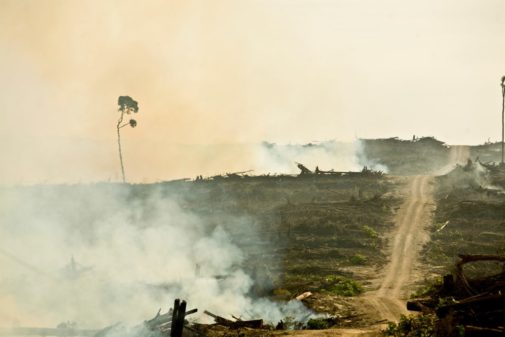
Open up burning in a newly cleared rainforest for a palm oil plantation in West Borneo, Indonesia. David Gilbert for Rainforest Action Network/Flickr
In addition, this push for aviation biofuels comes at a fourth dimension when palm oil biofuel use is set to increase steeply anyhow, due to new mandates in Republic of indonesia, and plans to ramp up biodiesel use in Malaysia, Thailand, Mainland china, Japan and Kingdom of norway. Palm oil utilize in Eu biofuels could abound significantly likewise, if aggressive Malaysian and Indonesian government and industry lobbying prevents an Eu Parliament decision—in favour of stopping back up for palm oil in biofuels—from being translated into policy.
Fortunately, large-scale aviation biofuels are not inevitable. Last Oct, merely earlier an ICAO 'Conference on Aviation and Alternative Fuels', 96 civil society organisations endorsed an Open Letter against a proposal for loftier aviation biofuel targets made by the ICAO Secretariat. [three] The conference ended without any biofuel targets being adopted at all. The manufacture hasn't given up, of course, and in June this twelvemonth a new ICAO Secretariat proposal will exist put before delegates, this time to make it as like shooting fish in a barrel as possible for airlines to reach 'carbon neutral growth' with the help of biofuels too every bit carbon offsets.
Preventing this new market for palm oil is vital if we are to avert yet more deforestation. But the reply cannot be to allow the aviation industry to keep expanding by burning ever more fossil fuels. It must exist to reverse the growth in aviation, resist airport expansions, motion subsidies from planes to trains, and for people to fly less if at all.
[1] http://www.biofuelwatch.org.uk/2017/aviation-biofuels/
[2] http://www.animus-csr.com/2017/01/23/the-real-touch on-of-palm-oil-and-failed-policies/
[3] http://www.biofuelwatch.org.united kingdom of great britain and northern ireland/2017/aviation-biofuels-open up-alphabetic character/
Natural pine forests rich in biodiversity threatened by logging in Sweden
By Kristina Bäck and Skydda Skogen, Protect the Wood, Sweden

Pär Wetterrot
The Ore Forest Landscape is an extensive woods landscape, much of it unprotected natural pino forest. Despite its high conservation values having been documented, the area is threatened past logging.
Most of the forest is managed by the state-owned and FSC-certified woods company Sveaskog, which has already logged more than 600 hectares of unprotected pine forests with loftier conservation values inside the Ore Forest Landscape since 2013, and plans to continue logging information technology. Sveaskog sells sawlogs, pulpwood for pulp and newspaper, and wood for biofuels. [1] Since December 2017 volunteers take been guarding the wood in an effort to forbid them from existence logged.
In the Ore Woods Landscape, several wood areas with high conservation values are scheduled for logging. The Swedish Forest Agency—the potency whose duty it is to balance production and environment goals—
refuses to survey key woodland habitats even after being informed of the rich biodiversity in these forest areas.
In one of the threatened forests, a tent has been set up for the volunteers who guard the forest from logging. These volunteers come from several organisations, such as Greenpeace, Protect the Forest and The Swedish Social club for Nature Conservation (SSNC). A list with 400 findings of 27 crimson-listed species provides clear proof of the high conservation values, and the NGOs take proposed to the County Administrative Board of Dalarna that the surface area be turned into a nature reserve. Sadly, this wish has been ignored by the authorities.
In a contempo picture show by Greenpeace [two], the urgent situation in the Ore Wood Landscape is described by Linda Spjut from Protect the Forest: "Sveaskog should support the fulfillment of the Swedish Environmental Objectives. Sveaskog's logging plans in this forest are a scandal. I call up many more Swedes would bring together the protest if they knew what is going on in their forests."
As well, in the same film, Greenpeace'southward Daniel Zetterström says: "We who protestation against the logging, demand that Sveaskog withdraws all their plans to log forests with high conservation values in Ore Woods Mural, and in the rest of Sweden. We desire the Swedish Forest Bureau to comport out an inventory in these forests, and that the government takes action to protect these areas."
Moreover, Nature and Youth'due south Linda Johannesson says: "It'south weird that state-owned Sveaskog proceeds with logging in biologically rich forests when at the same time our environmental objectives state that forests like these are the ones that should exist spared. Areas of natural pine forest this large hardly exist anymore this far south."
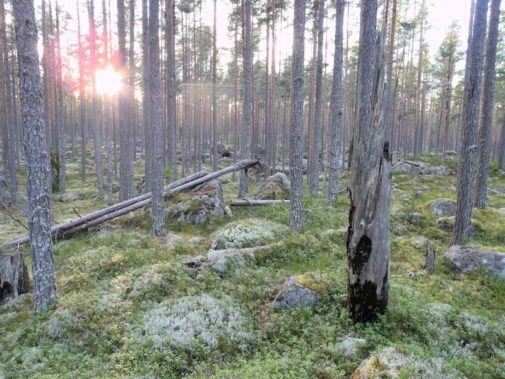
Ore Woods Mural, there are plans to log this natural pine wood. Sebastian Kirppu
Sebastian Kirppu, a woods biologist who has been deeply involved in the voluntary inventory of the forests, says: "The Swedish Forest Agency has based its assessment of the woods on 1 single field visit, without doing whatsoever proper inventory of woodland fundamental habitats." To Radio P4 Dalarna he says "Nosotros have a forestry industry which is FSC-certified, and therefore they should aid prevent cerise-listed species from disappearing. The forest companies have a and then-called 'sector responsibility' which means that they should avoid logging in forests with high conservation values, rich in biodiversity. At that place are besides authorities which are responsible for ensuring that Sweden achieves our Environmental Objectives and international agreements made with the UN, like the Aichi Target agreed in the Nagoya coming together in 2010. All these efforts are reduced to nothing when forests similar these, which are full of ruby-red-listed species, are being cut down. All the work we have done is lost!"
Recently, 22 organisations wrote an open up letter to the Swedish government demanding that logging should be halted in Ore Forest Mural, and that the forests need to be legally protected. The letter [iii] states:
"The logging in these forests and hence the transformation from biologically important woods landscapes into monocultural plantations will lead to irreversible loss of biodiversity. Past logging these forests, the Swedish Environmental Objectives cannot be properly achieved. Protecting the existing forests with high nature values is therefore a far more price-constructive measure for attaining these objectives than having to restore and re-create lost habitats."
The threatened forests of the Ore Woods Landscape are just 1 example of what is going on in Sweden. There are several other unprotected natural forests with loftier conservation values, and thus rich biodiversity, which are planned for logging. The last remnants of forests that have never been clear-cut before are at present existence cut downwards. At nowadays, only about 5% of Sweden's productive forest country is legally protected. Below the mountainous forest edge, only ii% is legally protected. More than 90% of Sweden'southward forests are, or have been, commercially used and are hence affected by systematic forest management.
In addition to this, appropriate care is defective when logging is done. In that location is a consensus among Sweden's leading biology scientists that the Swedish woods policy is threatening the biological diversity. In spite of this the Swedish government is advocating increased forest production and the utilise of bioenergy to supercede fossil fuels. They mind to the timber industry that argues that forests should be clear-cut in club to mitigate climate change. This thought happens to coincide with the industry's business interest. They bluntly state on a campaign website that the more than woods products yous buy, the better for the climate. The fact that logging natural forests and called-for them for energy will actually worsen the climate state of affairs is non mentioned.
A large proportion of the forests logged in Sweden are exported as raw textile, paper, pulp and other wood products to countries such as U.k., Germany and USA. Customers in these countries usually receive guarantees from the Swedish forest industry that these products are produced in a sustainable way. Protect the Woods testifies that Swedish forest companies' operations are often far from being sustainable, either environmentally or socially, especially in relation to the local population. There are numerous examples of FSC-certified companies logging old-growth forests with high conservation values and violating other criteria in the environmental certification rules. We therefore urge all concerned and customers in the countries that import forest products from Sweden to acquaint themselves with and to highlight the situation of the Swedish forests. Nosotros accept to stop the destruction of Europe's final one-time-growth forests and in order to do this we demand to cooperate internationally.
[1] https://www.sveaskog.se/en/well-nigh-sveaskog/sveaskog-in-brief/
[2] http://media.greenpeace.org/archive/Activity-to-Protect-Swedish-Forest-Landscape-Ore-Skogsrike-(Soundbites)-27MZIFJXI70MD.html
[3] http://world wide web.skyddaskogen.se/sv/arkiv/154-svenska-kategori/aktuellt/pressmeddelanden/4536-oeppet-brev-till-mikael-damberg-karolina-skog-om-ore-skogsrike9241
Booming merchandise in biofuels and biomass devastating the Czech Republic'south wetlands, farms and forests
Past Zdeněk Poštulka, Koalice pro řeky, Czechia

Koalice pro řeky
The overexploitation of soils in former Czechoslovakia dates dorsum to the 1950s, when collectivisation and the intensification of agriculture started to take their cost, devastating the landscape. Hedgerows and forests were cut downwardly in an attempt to make larger fields, and wetlands were drained.
Infrastructure designed to control rivers was also chop-chop expanded: although such works were already underway at the end of the 19th century, renewed efforts to dam rivers and brand hard concrete embankments became part of an arroyo based on the idea that "we volition command water and wind".
During the 1970s, works on land reclamation—more often than not draining wetlands and floodplains and converting them to arable country—proceeded rapidly, as policies prioritised arable farming. This newly tuckered arable farmland was created to compensate for country lost to concrete in the form of roads, the extension of settlements, etc. Merely these changes resulted in all-encompassing erosion and h2o pollution, as well as the overproduction of food.
Since the beginning of the 20th century the Czechia has lost around a meg hectares of wetlands, floodplain forests and agroforestry systems. [one] Drainage and other actions that impairment the h2o regime have taken place across 1.i one thousand thousand hectares of agricultural lands. 25.6% of the land's agricultural soils has been drained, more often than not by underground tubing drainage systems. [2]
Soil erosion is a serious problem, with 67% of our arable soil endangered by erosion, and 21 one thousand thousand tons of topsoil lost due to erosion every yr. Oilseed rape farming loomed, and afterwards the transition to free market economics in 1990 we started to export biofuel feedstock bolt (such as rape and wheat) to countries in Western Europe. The new business concern had begun.
Our lowlands have since been subjected to the specialised production of biofuel crops and too maize for the production of biogas, which is used to produce electricity. This has been accompanied by a reduction in livestock farming, as agriculture companies focused by and large on these crops, and chemic fertilisers have been used instead of manure. Ingather rotation favouring rape, maize and wheat likewise led to a rapid increase in the use of pesticides. Thus, groundwater in our lowlands is poisoned by glyphosates and other pesticide and fertiliser residues.
Nowadays, we need to set up aside at to the lowest degree 400,000 ha of degraded arable fields for the restoration of our mural through the introduction of agroforestry systems and the restoration of wetlands and floodplains. However, biofuels production continues to exist incentivised past national and Eu-broad policies. Nether such circumstances nosotros are doomed. Although the European Parliament recently voted to end EU back up for biofuels from oil palm from 2021 (pending an overall EU decision), it notwithstanding left all the other food ingather biofuels on the tabular array. Since oil palm forms such a loftier proportion of first generation biofuels in the Eu (33%), [3] the EU's demand for rape, wheat, soy and sugar pikestaff tin exist expected to rise substantially, should the European Parliament'south vote stand up.
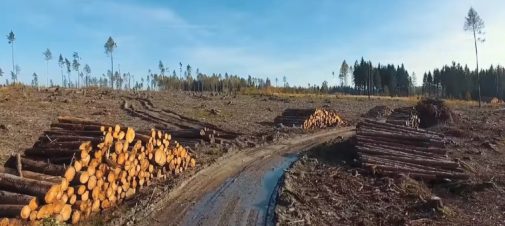
Logging in spruce forests increases soil erosion. Koalice pro řeky
The production of wood biomass is also a pressing concern. Remains of our 'close to nature' beech forests were destroyed in the 18th century when wood was used to power all kinds of early industrialisation. Due to prevailing ideas from the Austrian forestry schoolhouse, natural forests were replaced by spruce monoculture plantations. Present, still, these spruce plantations oft dice due to dry summers, storms and infestations of bark protrude. The beetle infestations in northern Moravia have reached unprecedented levels. Thousands of hectares of trees have been damaged and heavy machinery is beingness used to fight the bark beetle outbreak.
The wood is then exported to Poland and Austria, countries dependent on biomass to accomplish their sustainable free energy targets. Poland'due south example is particularly shocking, as they utilize co-firing of woods and coal in old coal ability plants equally a main tool for achieving their sustainable energy targets. Fifty-fifty when we have policies in place trying to protect our wood soils and promote 'shut to nature' forestry, nosotros can hardly foreclose this dash for energy biomass in neighbouring states.
Exporting this wood conflicts with our needs. We demand to leave dead woods on the spot in the damaged mountain catchments, to forestall soil erosion, enhance soil fertility, and enable stream and wetland restoration. Our mountain forests should be protected.
With regard to crop product for biofues, the European union ending support for get-go generation biofuels would be a positive step. Rape prices might so decrease, and so would the pressure on our mural. And then nosotros could more easily acquire land for the restoration of damaged ecosystems.
To accomplish responsible and sustainable biomass product, we propose the replanting of up to 150,000 ha of floodplain forests, preferably on arable soils with five years overflowing return frequency; 50,000 ha of agroforestry systems; and 200,000 ha of hedgerows and wetlands on vulnerable arable soils, orchards, and poplar-willow stands, or reed beds, partly as non-intervention forest for permanent carbon sequestration. Nosotros also propose the conversion of approximately 200,000 ha of the most vulnerable bandbox plantations to near-natural forests within the adjacent x years—providing an acting source of biomass—until newly-established coppice is ready for the first harvest for local use.
[1] http://www.hnutiduha.cz/sites/default/files/publikace/typo3/voda_zemedelstvi.pdf
[ii] http://www.hydromeliorace.cz/projekty/ishms/mapserv/pomoc/i_vekodv_p.htm
[3] https://world wide web.transportenvironment.org/newsroom/blog/will-eu-call-palm-oil-nations'-bluff?utm_source=T%26E+alert+emails&utm_campaign=2de064b7b1-EMAIL_CAMPAIGN_2018_03_02&utm_medium=electronic mail&utm_term=0_48950a8d32-2de064b7b1-119699241
Boosted references:
Ellison, D, et al, Trees, forests and h2o: Cool insights for a hot world, Global Environmental Alter, vol. 43, Elsevier, 2017
Horvath, M, and Poštulka, Z, Methodology for the management of new established peasant adn coppice with standard forests: instance study biocentre Čehovice Czech River Coalition, 2016, Olomouc
Kaliský, B, Novotný, P, Poštulka, Z, Solisová, V, and Šrytr, J, TULES – Trvale udržitelná lokální energetická soběstačnost (TULES – Sustainable local energetic cocky sufficiency), British Council, 2007, Prague
Pokorný, J, No wonder that is drought. Water Management Technical and Economical Information Periodical, 2017, vol. 59, No. 4., Prague
Poštulka, Z, Funding forests into the time to come: How the European Fund for Rural Evolution affects European forests, Case study Czech Republic, FERN, 2008, Brussels
Poštulka, Z, Degrading ecosystems to foreclose climate change: Can Czech forests and soils survive the dash for biomass?, FERN, 2012, Brussels
Poštulka. Z, et al, Feasibility written report of restoration of Blata stream in the cadastres of Vrbátky, Štětovice and Dubany. Czech River Coalition, 2015, Olomouc
Less meat, more than woods: Brighter Green's piece of work in Prc
By Wanqing Zhou, Brighter Green, USA

Brighter Greenish
Brighter Green, a New York-based public policy action tank, has been working with colleagues in developing countries on facilitating changes to decrease the consumption of animal-based foods, in society to reduce the impacts that these foods have on our climate, ecosystems, public health, socio-economical development, and animal welfare. China, where the market and multifaceted challenges accept reached unprecedented scales, is a focus for Brighter Light-green.
To nowadays the issue, Brighter Green worked with Chinese documentary filmmaker Jian Yi to create "What'south for Dinner?" (in 2009) and its follow-up piece "Six Years On" (in 2015), the start documentary series on the meat issue in China. [1] In 2016 Jian and Brighter Green colleagues visited N Carolina after Hurricane Matthew to document the harm washed to factory farms and the environmental impacts of the flood lagoons. Many of these farms are owned by China-based pork multinational WH Group. From a charter flight, some of the footage was_live-streamed to a Chinese news portal, getting over 77,000 views. [2]
These documentaries are complemented past comprehensive research. In 2011, Brighter Greenish released a policy paper, "Skillful Means: The Challenges of Mainland china'southward Run into with Factory Farming" [three], which explores the multifaceted impacts of industrial animal agriculture on China. In 2015, Brighter Light-green published a word paper, "The Triangle: The Development and Future of Industrial Animal Agronomics in the U.Southward., Prc, and Brazil", [iv] which highlights the deforestation acquired by the globalised meat and feed manufacture. It explores the "triangle of factory farming" linking the earth's 3 biggest players in the meat manufacture—the US, Mainland china, and Brazil—and analysing the dynamics shaping this triangle. These dynamics include industrial-scale cattle ranching and growing soybeans for animal feed, which contribute to all-encompassing deforestation in countries such as Brazil and Paraguay.
In terms of public date, since the kick-outset of the screening bout of "What's for Dinner?" in 2014, Brighter Green and colleagues have been building a network in China around the meat issue and its environmental and fauna welfare impacts. Today, the official business relationship on WeChat (the nigh popular social media app in China) has more than 6,000 subscribers, and two of the monthly live chats accept featured Brazil-based researchers talking about the connexion between meat and feed production, deforestation, and climate change.
In 2017, Brighter Green worked with the Skillful Nutrient Fund to advance the work in China on awareness raising, institutional outreach, and original inquiry, through the post-obit projects:

Vegan Energizing Nutty Breadstuff made with local ingredients at Good Nutrient Roadshow workshop in Taipei. Brighter Green
1. Skillful Food University: a Chinese-based website [5] that educates users about the impacts of industrial agriculture, peculiarly factory farming. The team worked with leading international organisations in this field to translate and share cutting-edge reports.
2. Good Food Roadshow: a workshop tour [6] where the team worked with plant-based chefs from the US and local farmers from 20 Chinese cities to educate the public about the truthful cost of the industrial food organisation, and the benefits of cooking good for you institute-based foods using fresh, local ingredients.
3. Good Food Hero Top: a symposium [7] where international experts on food systems, nutrition, ethics, and indigenous civilisation were joined past 100 Chinese food activists to inspire research and action on reducing animal-based nutrient consumption and promoting a ameliorate nutrient organisation.
In 2018, Brighter Light-green plans to further its work to reduce meat consumption in China, including advancing the Good Food University website, holding the second Good Nutrient Hero Tiptop, collaborating with Yale Hospitality to promote a healthier and more responsible dining policy in Chinese educational institutions, and conducting research on China's food movement and industrial creature-based food industry.
[ane] http://wfdinner.com/home/
[two] https://www.facebook.com/BrighterGreen/posts/10154760537161177
[3] http://brightergreen.org/china/
[four] http://brightergreen.org/the-triangle/
[5] http://www.goodfoodchina.cyberspace/
[half-dozen] http://world wide web.goodfoodchina.internet/roadshow.php
[7] http://www.goodfoodchina.net/top.php
What is existence sacrificed for your premium piece of steak?
By Mary Louise Malig, Global Forest Coalition, Republic of bolivia

Jai Mansson
At that place are numerous initiatives the world over asking consumers to reduce the amount of meat they consume. Some campaigns aim to ease modify slowly but surely, by convincing consumers to have ane solar day in the week when they do not eat meat. Many Catholics, by giving upwards meat for the flavor of Lent (xl days of sacrifice and reflection), signify that eating meat is important to them and that it is a cede to requite it up. Simply what is actually being sacrificed to give you lot that piece of steak? It turns out the price is steep, it's not just the animals themselves, information technology includes our forests and our climate equally well.
Pan out to the bigger picture, and look at the lengths that countries and corporations go to, negotiating trade agreements, deals and tariffs, and many more, effectually beef. Where will cattle exist raised? How much beef tin be produced and sold? What might a state be ready to exchange in return for increased market access for beef exports? For the European Union and the regional Mercosur bloc —comprised of Argentina, Brazil, Paraguay and Uruguay— negotiations are very much focused on beef, and who gives and gains what in return, in beef and in a whole range of other sectors from services to government procurement. It has taken them 20 years of end-go talks, and they have yet to reach a deal. All this might be well-nigh to change however. In recent months, the EU-Mercosur agreement has been gaining momentum, moving ahead in a seeming rush to shut the deal and sign it.
A news article virtually the recent rounds of negotiations said: "At its heart, any agreement will depend on beefiness and ethanol—only mainly the beef. If Europe agrees to buy enough prime Latin American beef at low tariff levels, Mercosur will drop tariffs on leading EU exports such as cars and machinery." [ane] What Mercosur wants is to export prime meat to the EU. This with ethanol is one of its biggest ambitions. When one hears this ane could recall that the entire economy of Mercosur depends on meat exports and that this is crucial for the future of Mercosur and its people. However, a deeper look reveals that this actually reflects the interests of the large agribusinesses in those countries who wield a lot of influence.
Meat is an important consign for Mercosur, only it's non its only export. The total exports of Mercosur to the world are The states$ 221 billion and the exports of meat to the world are Us$ ix billion. Exports to the EU were around US$ 42 billion and meat exports were around The states$ one billion. A quota may or may not boost the meat industry of Mercosur simply it is definitely being used by Mercosur to justify the importance of the deal. Nevertheless, to substitution this meat quota which is rather pocket-sized when looked at from a macro perspective, for something so much more than significant such as regime procurement, services and a host of other measures, is not a win at all.
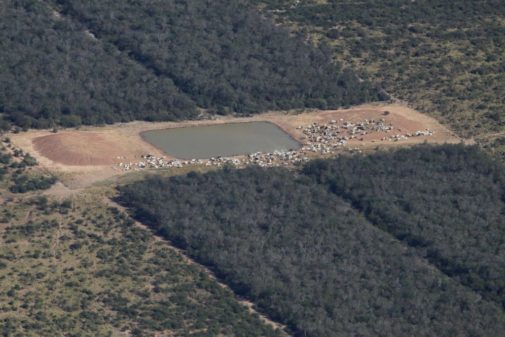
Deforestation for cattle ranching in the Chaco, Paraguay. Miguel Lovera/Iniciativa Amatocodie, Paraguay
Going into the specifics of the current negotiations, the maximum quota that Mercosur might attain for beef would exist something in the region of 100,000 tonnes. From a macro perspective, and because the value and quantity of their existing meat exports, this is non such a significant win—unless, you are looking at this negotiation from the perspective of the large cattle farmers and other meat-related corporations in Mercosur who stand to benefit the most from this deal.
The singular drive to increase meat production by Mercosur governments strikes fearfulness into the hearts of those who have already witnessed and continue to witness the large-scale devastation of forests, biodiversity, ecosystems, communities, human health and animals, as a effect of unsustainable industrial livestock and feedstock farming spreading across the countries of Mercosur and neighbouring countries in Southward America.
As many studies have already shown, with case studies and on the ground accounts, the sector brings in its wake a range of straight and indirect negative impacts including massive deforestation to brand mode for cattle ranching and monoculture soy plantations, and the widespread displacement and dispossession of land of communities, wood dependent peoples and Indigenous Peoples, as well as man health and animal welfare impacts. [ii] For instance, the 2016 Land of the World's Forests study refers to an analysis in 7 Southward American countries which institute that 71% of deforestation betwixt 1990 and 2005 was driven past increased demand for land while in Brazil the effigy was even college, at 80%.
Within the EU, Irish and French farmers had been ringing alarm bells about the impacts that increased imports of beefiness from Mercosur would have on small farmers in these countries. For example in September 2017 the chairman of the Irish gaelic Cattle and Sheep Farmers' Association said: "The ICSA is extremely concerned at this. If such an offer (85,000 tonnes of beefiness for Mercosur to the EU) is tabled it would have a very severe impact on European beefiness markets and would hit Irish beef exports especially difficult." [three] On 21 February 2018 French farmers held tractor protests to voice like concerns to
Macron. [4]
Furthermore, the EU-Mercosur deal is an extremely lop-sided bargain. It seems set up to give away much of Mercosur'south sovereignty—in the form of its intellectual belongings rights, its services, its regime procurement and so much more—in exchange for selling an increased amount of premium beef.
It'due south time to listen to the deafening chorus of peoples' voices opposing this deal. Deportment must be taken to put pressure level on determination-makers and governments to stop them signing the disastrous Eu-Mercosur deal.
A brief guide to the on-off EU-Mercosur Agreement negotiations
Why is a deal that was being negotiated on and off since 1999 with the coming into force of the Cooperation Framework Understanding, suddenly the subject of a frenzied race to accomplish an agreement in 2018? And more than importantly, what are both sides aiming to become out of this deal?
Mercosur is a South American merchandise bloc established by the Treaty of Asunción in 1991 and the Protocol of Ouro Preto in 1994. Its total members are Argentina, Brazil, Paraguay and Uruguay. Venezuela is also a total member but has been suspended since one December 2016. Acquaintance countries are Republic of bolivia, Republic of chile, Republic of peru, Republic of colombia and Ecuador.
The current negotiations are between the European Wedlock, a 28-nation bloc, and the founding members of Mercosur: Argentine republic, Brazil, Paraguay and Uruguay.
The early negotiations did not really take whatever common ground that the ii blocs could reach. The EU considered Mercosur every bit as well adult and then it did not qualify for the Special and Differential Treatment afforded to developing and to the lowest degree developed countries in trade negotiations. The EU's quotas restricting agronomical imports were a point of contention for Mercosur, and on the other side, the Eu was dissatisfied with Mercosur's offers on the automotive sector. This stalemate continued from 2004 to 2010, when negotiations briefly resumed, simply to be paused once again in 2012, and and so restarted in 2016.
Mercosur is one of the world'due south leading exporters of bovine meat. Their exports to the world accept jumped since 2004. In 2017, they placed 2 million tons of fresh beef on the international market accounting for around U.s.$ nine billion at an average toll of U.s.$ iv,538/t. The main markets for Mercosur's bovine meat include China, Russia and others. Merely the Eu is of particular interest considering it'due south a proficient destination for prime beef.
[i] https://world wide web.political leader.eu/article/mercosur-eu-deal-faces-race-confronting-the-clock/
[ii] Case studies from Brazil, Bolivia, Republic of india, Paraguay and Russia tin be seen in our report "What's at Steak" https://globalforestcoalition.org/whats-steak-real-price-meat/
[3] http://en.mercopress.com/2017/09/xix/irish-and-french-farmers-warn-about-mercosur-eu-beefiness-negotiations
[4] https://af.reuters.com/commodity/africaTech/idAFL8N1QB4P6
Editorial Team: Ashlesha Khadse, Mary Louise Malig, Ronnie Hall and Simone Lovera
Editors: Isis Alvarez and Ronnie Hall
Layout, Graphic Design & Photo Enquiry: Oliver Munnion
Donate to GFC here.
This Woods Comprehend was fabricated possible through support from various GFC member groups and contributors, including Misereor and the International Climate Initiative (IKI) of the German Federal Ministry building for the Environment, Nature Conservation and Nuclear Rubber (BMU).
The views expressed in this publication are not necessarily the views of our contributors.
Source: https://globalforestcoalition.org/forest-cover-55/
0 Response to "Primary Drivers of Deforestation Un Soy, Beef, Wood Prducts"
Postar um comentário